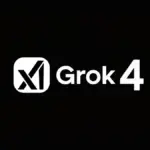Grok 4 is Out – and It’s Making a Real Impact
The latest model from xAI, Grok 4, has officially landed, and it’s already clear this one’s significant. Rather than just another incremental upgrade, Grok 4 has genuinely changed the game, setting impressive benchmarks and performing noticeably better in everyday tasks. Let’s get into the details.
Grok 4 Takes the Lead on Benchmarks
First up, benchmarks. Grok 4 didn’t just perform well – it clearly took the lead. On the ARC AGI 2 benchmark, known as one of the toughest tests for evaluating general intelligence in AI, it doubled the score previously held by Claude Opus. Even more notable: Grok 4 became the first model ever to achieve a perfect 100% on the International Math Olympiad benchmark. In practical terms, it means Grok 4 is very good at complex reasoning tasks, which is exactly what you’d hope for in a top-tier AI assistant.
Behind-the-Scenes Improvements
Two things made Grok 4 notably smarter. First, xAI invested 10 times more computing resources into the second phase of its training (the reinforcement learning stage), helping the model fine-tune its reasoning capabilities significantly. Second, Grok 4 was trained with tool usage embedded directly into the process, rather than tools being something the model had to figure out later. To put it simply, previous models had tools available but didn’t really internalize how to use them naturally. Grok 4, on the other hand, feels like a model that “grew up” with the tools, which makes it inherently smoother and more intuitive.
How Grok 4 Works: Multiple Agents, Better Answers
One distinctive feature is Grok 4’s use of a multi-agent approach. Basically, the model runs several internal agents, evaluates their different outputs, and picks the best response. It’s not completely new technology, but xAI has openly explained how they do this, which adds credibility and transparency to the approach.
Real-World Performance: Practical and Effective
Benchmarks aside, the real test is everyday usability, and here Grok 4 genuinely delivers. Its greatest strength might be how concise and precise the responses are. Unlike some other models that tend toward lengthy or overly detailed replies, Grok 4 tends to give clear, straightforward answers. It’s great at tasks that involve planning, strategy, or decision-making, striking just the right balance between being helpful and not overwhelming the user with options.
Prompt adherence – how closely the model follows the instructions given – is another major plus. Grok 4 consistently respects user prompts in a way that feels dependable and predictable, making it a solid assistant for tasks requiring clear instructions and structured responses.
Limitations Worth Considering
Grok 4 isn’t the best at everything. It does a decent job with coding, but when it comes to detailed UI or aesthetically polished results, models like Claude still have an edge. Developers and users online have echoed this sentiment, suggesting Grok 4 is probably not your go-to for front-end or visually sensitive coding projects. But if you’re doing more logic-driven development or strategic planning, it’ll handle those tasks with ease.
Pricing and Availability
In terms of cost, Grok 4 Heavy – the version leveraging that multi-agent approach – comes at $300 per month. That’s about 50% higher than the usual $200/month competitors offer, so it’s definitely on the premium side. However, the performance and capabilities might justify the extra expense if strategic decision-making and efficiency are top priorities.
Grok 4 is accessible globally through both web apps and an API. It comes with a generous 256K token context length, though API users should note that pricing doubles after hitting 128K tokens.
What’s Coming Next?
Grok 4 is already quite impressive, but xAI isn’t stopping there. Plans for future enhancements include introducing enterprise-grade physics simulators and other advanced tools aimed at pushing the boundaries of what generative AI can accomplish. Their stated goal is achieving tangible technological breakthroughs by late 2025 or into 2026, and given their current trajectory, this seems realistic.
In short, Grok 4 stands out not just because of impressive benchmarks but also because it’s proving genuinely practical and effective in real-world scenarios. It’s a meaningful step forward in AI, especially for anyone who relies on clear, concise, and accurate results.




